

 The South African
The South African
(incorporating Museum Review)
by I.B. Copley, Dept. Neurosurgery, Medunsa
After the fall of Pretoria on 5 June 1900, the British forces found themselves in command of most strategic points, but with enormously extended lines of communication. In the Western Transvaal, communications were maintained through huge tracts of inhospitable country, 'beastly to fight in', rough hills, tenacious bushes and hard stony ground with infrequent sources of water, especially in the southern winter.(1)
Conditions were ideal for guerrilla warfare conducted by tough, unsophisticated fighters who were brought up as horsemen and marksmen, who knew the country intimately and who could adapt themselves to harsh conditions using the topography to their advantage.
The remainder of the Anglo-Boer War was, in fact, mostly conducted in this manner: depleted, thinly-spread trained troops with baggage and equipment, cavalry, artillery and supporting services pitted against highly mobile, self-supporting, relatively unencumbered partisan horsemen.
11 July 1900 marked the beginning of this type of war with four Boer actions,(a) of which the action of Silkaatsnek was but one of three successes, with resultant timely encouragement to Boer morale in the Western Transvaal, and 'dismay amongst English [sic] garrisons and outposts.'(2)
After the fall of Pretoria on 5 June, and the battle of Diamond Hill - 10 miles (16 km) east of Pretoria - on 11 and l2 June, the Boer elements disappeared into the wilderness north of the Magaliesberg, a single mountain range forming a natural barrier rising near Diamond Hill and extending just north of Pretoria, and a further 100 miles (160 km) to the west. The southern aspect of the range generally presents a sheer cliff face, so that wheeled traffic can only travel over it at certain points; Silkaatsnek (b), about 17 miles (27 km) west of Pretoria, is one of some seven passes or Neks. (Map 1) These passes became features of great tactical importance in the campaign of the Western Transvaal.(3)
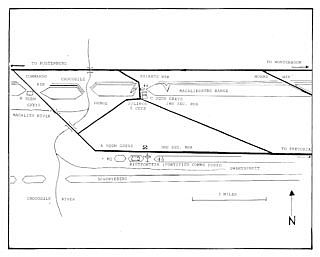
Map 1: Schematic Rietfontein area
High resolution pdf version of mapGeneral De la Rey had commanded the northern sector of the Boer forces at Diamond Hill. After this battle, De la Rey, who also commanded the Western Transvalers, fell back to the Bronkhorstspruit-Balmoral area. The Boers now realised the futility of set-piece battles and had come to the conclusion that the furtherance of the war would have to be by unconventional means - guerrilla warfare. De la Rey was sent back to reorganise and revitalise the Western Transvaal burghers who had begun to think that the war was virtually over and had surrendered Rustenburg to Lieutenant Colonel R S S Baden-Powell. Thus, on l0 July, De la Rey was travelling north of Silkaatsnek towards Rustenburg with some 200 men, when his scouts brought information that the Nek was lightly held and that the commanding shoulders of the Nek had been ignored. He decided to attack.
The 2nd Dragoons, Royal Scots Greys, commanded by Lt Col the Hon W P Alexander Bart, were at Derdepoort, a cavalry outpost, 4 miles (5,6 km) north of Wonderboom fort on the railway line, and were under instructions to relieve the 1 500 men and two batteries at Silkaatsnek and Commando Nek under Baden-Powell. He, in turn, had been ordered west to Rustenburg on the evening of 6 July to support Maj Hanbury-Tracy's garrison which was threatened by 400 Boers. On 7 July, the Scots Greys were to be relieved by the 7th Dragoon Guards. Owing to a mistake in the orders (which omitted the words '3.5 m south of Waterval'), the Dragoon Guards did not arrive at Derdepoort until noon.(4) The departure of three squadrons of the Scots Greys was thus delayed. To save time they and two sections of 'O' Battery, Royal Horse Artillery (one section of two guns was left with the Dragoons), took the direct road to Rustenburg on the exposed northern side of the Magaliesberg. The Royal Horse Artillery (RHA) was commanded by Maj Sir J H Jervis-White-Jervis, Bart. The moving column of winter dust was being observed by the Boers atop the Magaliesberg, but they were unable to gather sufficient numbers to mount an attack in time.(3) The Scots Greys also had with them a troop of fifty Australian Horse.(6)
Baden-Powell had stressed that both Silkaatsnek and Commando Nek should be held, and that with a reserve detachment should be stationed between the two on a hill 2 miles east of the Paul Kruger bridge over the Crocodile River on the southern Pretoria - Rustenburg road via Commando Nek.(7) (Map 1)
The Greys were retracing their route of 5 June in the flanking movement on Pretoria after the Kalkheuwel Pass battle.(8) The RHA had taken the same route a day later. On the first occasion the Greys had left A Squadron to occupy Silkaatsnek. On this occasion, a month later, it was quite dark by the time they reached Silkaatsnek and C Squadron of the Greys (Maj HJ Scobell, Capt C J Maxwell, Lt T Conolly and 80 men) was detached to hold the Nek with the two guns of 2nd Section 'O' Battery under Lt W P L Davis. (Map 2)(9,10) The main party continued over Silkaatsnek for a further 3.5 miles to reach the Crocodile River where they did the best they could in the bitter cold after their transport failed to turn up. A deserted shop was put to good use by their medical officer, Maj A F Russel, and the regimental chaplain.(11)
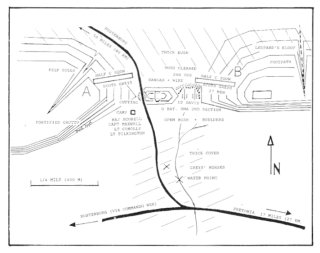
Map 2: 10 July - Disposition of the Scots Greys under Major Scobell, 75 men
High resolution pdf version of mapThe next morning, on 8 July, B Squadron Scots Greys (Capt E A Maude) and the Maxim machine gun crossed the bridge over the Crocodile River and proceeded westward 2 miles (3,5 km) to Commando Nek.(6)
Headquarters and A Section of the Greys moved 2 miles in the opposite direction to Baden-Powell's fortified camp at Rietfontein taking with them the fifty Australian Horse and the 3rd Section of RHA under Maj Jervis.(12,13)
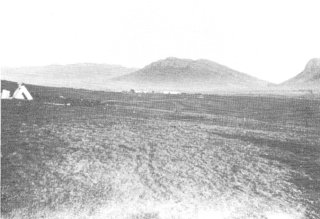
View of Silkaatsnek and the Crocodile River Crossing from the western end of Rietfontein camp
Near the western end of a long series of low hills was the fortified communications post of Rietfontein. It not only covered the Crocodile River bridge, 2 miles (3,5 km) further west, but also the passes of Commando Nek and Silkaatsnek at distances of 5.375 (8,6 km) and 3.125 (5,1 km) miles, respectively.(14) The post was in heliographic and telegraphic communication with Pretoria.(15)
Silkaatsnek is a U-shaped gap in the Magaliesberg range affording easy passage to wheeled vehicles.(c) At this point, the Magaliesberg rises some 1 300 feet (396 m) above the plain whilst the ascent over the Nek is a mere 350 feet (107 m). The Nek is divided into two halves by an elongated rocky outcrop or kopje. The road over the Nek takes the western or left-hand side of the kopje. At the top of the slope, the original road passes through a cutting in the Nek for 20-25 yards (13 m) next to the kopje.(16)
The kopje overlooks the pass on either side by some 75 feet (23 m), but is itself overlooked by the shoulders of the mountain range on either side, which rise another 950 feet (290 m) immediately on the eastern side, and more gradually and step-wise to the west. The western buttress is almost separated from the main range by a deep gully on the northern slope.
The northern aspect of the range has a fairly constant slope produced by the tilt of the quartzite rock beds. Apart from gulleys and ravines caused by erosion of dykes and sills, an ascent can be made almost anywhere. By contrast, the southern aspect has a sheer cliff face and can be climbed only in a few places on foot, occasionally on horseback. During the war, the northern slopes and gulleys were covered in thick bush, whilst the southern side supported a more open savannah except at the base of the cliffs and, in the case of Silkaatsnek, along the course of the stream, where the bush was much thicker, 'with mimosa trees half a mile broad.'
A footpath one mile to the east, at Leopard's kloof, affords the nearest crossing point to the Nek. It was feared that it might provide the Boers with a means of outflanking the positions in Silkaatsnek (Map 2), but it probably did provide a route to the summit.
On Tuesday 10 July, the 2nd Battalion The 10th Foot The Lincolnshire Regiment, under Col H R Roberts, was sent out from Pretoria to relieve the cavalry who were needed to join a column forming under Col H L Smith-Dorrien to clear out the Boers south of the Magaliesberg and further west.
The area was also familiar to the Lincolnshires. On 15 June 1900 they had marched the same road, bivouacked at Rietfontein and on 17 June had marched 10 miles beyond Commando Nek where C Coy had remained for a while. The battalion had been back in Pretoria since 20 June.(17) (Map 1)
Five understrength companies reached Silkaatsnek on the afternoon of 10 June after their 17 mile march from Pretoria. Two of the companies, D and F, with a Maxim machine gun, who were to have gone on to Commando Nek, bivouacked at the foot of the Nek next to the road half a mile to the rear in anticipation of continuing their march the following day.(18) (Map 3)
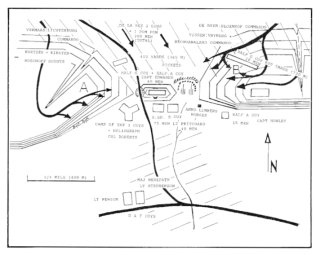
Map 3: Evening July 10 to sunrise July 11
High resolution pdf version of mapCol Roberts brought orders from Pretoria to Col Alexander to take his three squadrons westwards to join Col H L Smith-Dorrien and would presumably have had to travel via Rietfontein first, to hand over the orders and then to have gone on to Silkaatsnek. In so doing, he would have been the last to arrive at the Nek. The rear-guard, G Coy (Lt L Edwards), arrived at the Nek only at 16:30, half an hour before sunset.(19) He kept D and F Coys (Maj E Herepath, Lt H E Newsum, Lt Stephens) where they had bivouacked as they were too tired to continue the further 7 miles to Commando Nek. The time available to reconnoitre his position before sunset consequently would have been very limited.(d)
Col Roberts took over from Maj Scobell of the Scots Greys. Major Scobell was aware of a possible attack by De la Rey and 1 600 Boers and had notified Alexander who had heliographed Headquarters in Pretoria informing them of the situation.(20) This was endorsed by Col Roberts who then sent another message to Pretoria requesting reinforcements.(21,22) Major Scobell indicated to both Col Roberts and Capt Edwards that, on occupying the Nek, he had divided his squadron into two, having most (55 men) of his available force of 75 men about one-third of the way up the shoulders on either side. The two guns had been placed in the gap to the east of the kopje, and had been protected with sangars and wire entanglements in front of them. The field of fire was somewhat limited as the bush to the front had only been cleared to 200 yards (183 m) by this stage (Map 2).(23,24) Maj Scobell did not appreciate being left at the Nek. He considered it a bad position where the guns would only hamper him.(25) At Rietfontein no one believed that the Boers would attack C Squadron in the Nek.
Col Roberts withdrew the Scots Greys to the south of the kopje against their departure the next day. (The Greys slept in column of troops with their rifles alongside them and their horses stayed in the bush at the bottom of the Nek.(25) He sent out G Coy (30 men) under Capt Edwards to place outposts for the night. They were reinforced with half of A Coy (15 men). The remaining half of A Coy under Capt J J Howley was sent to cover the right rear, to guard against a flank attack by way of the footpath over the mountain. (27,28)
The third company (B Coy, Lt G F Prichard) was kept under the central kopje with the Scots Greys in reserve.
At 18:30, Capt Edwards began setting the combined pickets of G and A Coys, which were placed facing north, 400 yards (365 m) out on the left, presumably on the road towards Rustenburg on the kopje, and 800 yards (732 m) out to the right of the northern entrance to the Nek, where he placed his colour sergeant and eighteen men.(29) These were the positions after sunset on 10 July. The western buttress does not appear to have been occupied at all; possibly Col Roberts thought it was sufficiently protected by the deep, rocky gully on the north-west, covering the picket's left flank. Col Roberts might have rearranged his defences by daylight the next morning given the opportunity of redeploying the 150 men originally at his disposal. (Map 3)
The Transvaal winter weather prevailing during July meant that night-time temperatures would have dropped to near zero degrees centigrade, more bearable for the troops due to the dryness and lack of wind. The bright, sunny daytime conditions allowed temperatures to rise during the day to about 20degreesC. With little wind, dust, smoke from bush fires, and facing the sun's northern arc, visibility could be considerably impaired, particularly from Rietfontein towards Silkaatsnek. A full moon provided good lighting the whole night, rising and setting with dusk and dawn respectively. However, during those hours of semi-darkness, the Boers were able to creep into position. Two hundred men had started out at 02:00 to climb up the mountain in order to be on the shoulders of both sides of the Nek by dawn. They were to wait for the guns to fire twenty shots before attacking.(30) Commandants De Beer and Visser were positioned to the east, Coetree, Kirsten and Boshoff to the west (Map 3).(31)
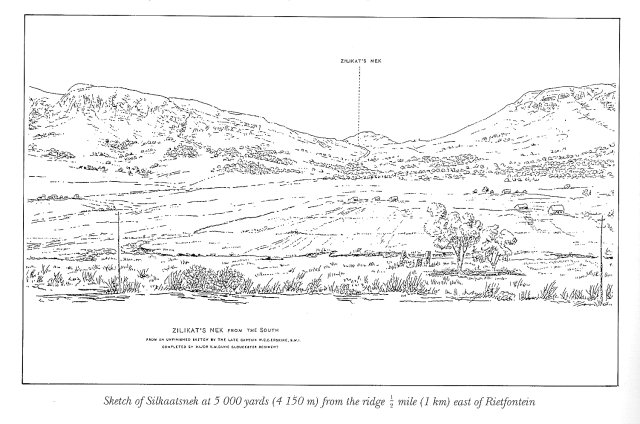
It would seem that the start of the attack did not go entirely according to plan, since at 05:30 (Times), daybreak (Official History), dawn (With the Flag to Pretoria), 05:50 (Regimental History), first light at 06:00 (With Gen French and the Cavalry), there was firing from the Lincolnshire pickets on the right. There is no mention of an initial bombardment. The picket on the right had been surprised, surrounded and forced to surrender after the loss of four men killed.(32) This was the provenance of the initial shots. Seven or eight minutes passed before the Boers replied from the east.(33) The roar of musketry could be heard plainly at Rietfontein.(34)
The With the Flag version is that, at dawn, Boer sharp-shooters opened up on the British pickets and drove them in, but the Times History simply states that at 05:30, a sentry noticed Boers on the summit of the eastern shoulder and gave the alarm by firing his rifle. The Official History states that at daybreak, Mauser fire broke out from the peaks. The latter two statements correspond with evidence given to the Court of Enquiry by Maj Scobell and Capt Edwards respectively, who were unaware of the fate of the right picket. Men of the companies in camp were standing to their arms but had not quitted their lines.(35) Scobell's men were up and ready to move out. An ominous silence followed the alarm. Maj Scobell had time to climb halfway up the kopje to assess the situation.(36)
In any event, pandemonium must have broken out. The left picket fell in towards the kopje and the guns, whilst the rear flank guard (A Coy) also came in to support the guns as the bullets flew harmlessly overhead. The Scots Greys were in a good position to climb the eastern end of the kopje to answer the enemy fire from the right. (Map 4) Col Roberts then asked them to reinforce his left picket which they did with an officer and twenty men. The enemy was seen working across their front to the left, eventually firing on the picket from some rocky ledges further left.(37)
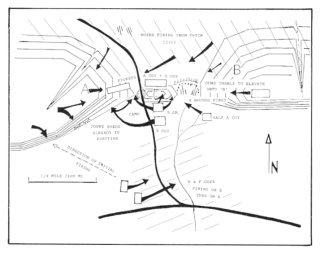
Map 4: Wednesday morning 11 July: The Attack
High resolution pdf version of map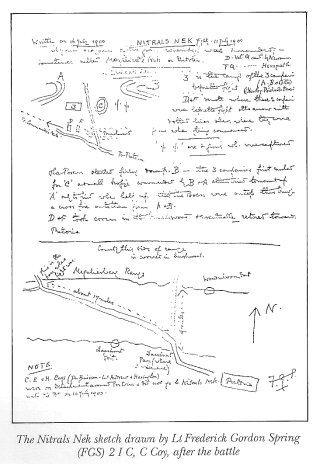
The men with the limbers, ammunition wagon and horses of the artillery on the right had further to go to reach shelter. After covering only a third of the 300 yards, the enemy had the range and killed or wounded seven men and most of the horses and mules.
The guns lacked the time and opportunity to engage the enemy. The increasing rifle fire prevented service of the guns as anyone visible above the sangar was shot down. They managed to fire shrapnel, with the fuse set at 1, and then all their case, about eight rounds in total, against the Boers creeping through the bush in front of them and over the shoulder of the mountain to the north-east. Even digging under the trails failed to provide sufficient elevation to deal with the plunging fire of the Boers, now on the eastern heights which dominated the gun sangars. A driver and four horses of the RHA managed to escape from their wagon park via the bush along the stream which rises just below the summit of the Nek on the east. (Map 4)
B Company, under Lt Prichard, was sent across to occupy the western buttress, which overlooks not only the kopje but the whole Nek, in order to fire across to the eastern side where the attack started.(38,39,40) However they found, 'when halfway up, that the Boers were on top'.(41) They continued up the Nek until, at 07:30, they were reinforcing the left picket between them and the Scots Greys.(28) (Map 4) An officer ('Pilkington') and twenty-five of Scobell's men were sent at 09:30 by Col Roberts to reinforce the left side at the request of Capt Edwards.(42)
The British force on the kopje then found itself in a crossfire between Boers to the north-east on the well-wooded northern shoulder and those to the south-west on the rocky buttress commanding the pass. Shortly afterwards, the Boers advanced through the bush and attacked the centre kopje and the right of the left picket. In creeping closer, ground was gained by three or four good shots establishing themselves when cover was good; under their fire, others could creep up.
The Nitral's Nek document, drawn on 16 July 1900, also stated that the shooting was directed from the western buttress 'when firing commenced' on D and F Coys commanded by Lt Newsum and Maj Herapath, respectively. However, in his Board of Enquiry evidence, Lt Stephenson, second-in-command of F Coy, stated that they had been under fire 'first from our right, then the centre, and then from our left.' Presumably this was because their own fire was returned.(43) D and F Coys took cover in the brushwood along the road and the stream. At first Maj Herapath directed fire from both companies on to the Boers moving in from the eastern buttress on the right, until it endangered his comrades on the kopje. Fire was then directed on to the western buttress on his left. At about noon, the men on the kopje gave a cheer, thinking that D and F Coys were reinforcements coming up, when, in fact, they were only moving to another position.(44)
In their haste to reach cover, personnel in the main camp (of A, B and G Coys) situated to the east of the road near the summit, left the heliograph behind in the camp, which was also exposed to the cross-fire. Despite several attempts to reach it, it was not recovered until shortly before sunset.(45) Communication with reserves at Rietfontein and Commando Nek was thus severed. However, just after 06:00, Col Alexander heard the firing and reported to Pretoria that the Nek had been attacked.(46,47)
Attempts by both the Greys and the Lincolns to reach and bring in the heliograph resulted in at least three casualties. It remained about 150 yards down the slope from the kopje.(48)
Unfortunately, Col Alexander did nothing else about it. Having no communications with the Nek, he could not accurately assess the strength or direction of the attack. He had, in effect, no forward observation post.
Meanwhile, a section of the Boer force under De la Rey was bringing up a Vickers-Maxim, two field guns and two one-pounder Maxim Nordenfeldts (Pom Poms), to make a frontal attack on the kopje from the cover of the thick bush. The forces on the eastern and western buttresses continued with an enveloping movement.(49,50) The firing lasted about two hours until 9:25. Capt Edwards saw that the Boers were working round his left flank and sent to Col Roberts for reinforcements. Colour-Sergeant C Breatwick of B Coy was detailed from the camp with half a company to support Edwards. Edwards had also requested the resupply of ammunition. Lt Prichard was killed at 9:45 and the colour-sergeant took command of the company.(51)
At about 9:00, in spite of heavy fire below the Nek, Col Roberts succeeded in getting a message through to Col Alexander, saying they were hard pressed. He requested a bombardment of the eastern buttress as his own guns had been unable to continue firing.
At this stage the action developed into a struggle for the guns; the gunners could not leave the shelter of the sangar despite covering fire from the kopje against an enemy almost invisible amongst the vegetation and boulders. Although Alexander regarded the position as lost, he allowed his two guns at or near Rietfontein with a line of horsemen to advance to shell the shoulder from 3 000 yards (2 700 m) range in response to Roberts' request (Map 5) .(52) This, plus the fire from D and F Coys, slowed down the Boer attack and reduced fire from the east. Regrettably, after an hour; Alexander was worried about shelling his own people and considered his two guns to be in danger from the possible approach of Boers and withdrew them to 5 000 yards (4 500 m) (Rietfontein area). He also ordered D and F Coys to retire to Pretoria, but merely warned Capt Maude at Commando Nek, without giving any explicit directions, to rejoin him. Maude, thinking Silkaatsnek already captured, retired towards Pretoria via Rietfontein.(53,54)
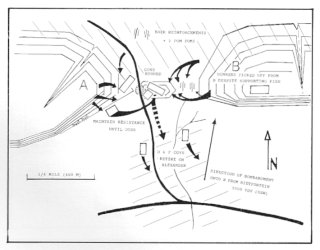
Map 5: Wednesday, 11 July - Midday
High resolution pdf version of mapAt 10:30 the Boer guns began shelling the left picket. Edwards attempted unsuccessfully to extend his left flank. The Boers completed their flanking movement opening a severe fire on the picket and on the kopje.(55)
B Coy had been forced down the Nek, but Capt Edwards moved these men 'further up the hill to the west' under cover and maintained this position until 16:00, firing sporadically, due to the desperate shortage of ammunition. Because of shelling by their own guns now in Boer hands, and further flanking movement by the enemy, he retired his men half-way down the south side of the kopje and escaped with them at dusk to Rietfontein.(56) There were two officers and thirty men.(57,58) The second officer was possibly Maj Scobell who escaped much later (since Scobell and Edwards were the only two officers from the kopje to give evidence at the Enquiry).
At about 14:00 word was brought to Scobell that Boers were on the eastern end of the kopje. Scobell and Conolly went to look and found seven or eight boers establishing themselves 40 yards away. A shot disabled two and dispersed the rest. A quarter of an hour later, Lt Conolly was killed, shot through the head at a few yards range as he was taking five or six men across the centre of the kopje.(59)
After shooting down the gunners at about 15:00, the Boers overran the guns, an event which caused the Boers their greatest losses. Just as the buttress overlooked the kopje, the guns were overlooked by the kopje, so that the tables were reversed. It was here that Lt Thuynsma of the Free State Artillery, commanding De la Rey's artillery, greatly distinguished himself.(68) Once captured, the guns, which it had not been possible to spike, were taken further north and turned, by 16:00, against the troops on the kopje with considerable effect.
For a couple of hours, a state of suspended animation supervened due to a lack of ammunition on the Imperial side, and possibly also on the Boer side. Skirmishing between small groups of men continued, however; and during the afternoon, the Boers worked their way around the kopje, as they had worked around the guns. They also gained a hold on the eastern end of the kopje by 15:00 and it was evident that the men on the left had been overpowered. The Boers were then within 200 yards.(61)
In the course of the morning, Sgt T Rawdin with D and F Coys, who was later decorated with the Distinguished Conduct Medal, took over the jammed Maxim (which had become a target resulting in several of those serving the gun being bowled over). Sgt Rawdin sent his comrades to take cover whilst, alone, he deliberately stripped the gun, replaced the parts and turned the weapon once more upon the enemy.(62)
During the day, Lt Cato, RAMC, who was attached to the battery, did particularly well in attending to the wounded.(63)
Unfortunately, the survivors and wounded of A and G Coys and the squadron of Scots Greys, with the gun crews, were now marooned on the kopje with little hope of rescue. Thirst and lack of ammunition made the situation even worse. The heliograph was rescued and contact was made with Alexander; The sun, sinking behind the western buttress, allowed time for only the first half of Alexander's reply to be received, but it did not encourage any hope of rescue. (Map 6)
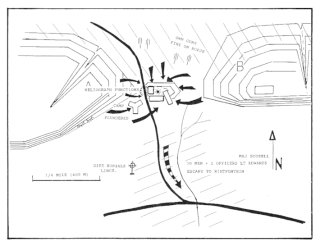
Map 6: 11 July - Afternoon to Nightfall: The Surrender
High resolution pdf version of map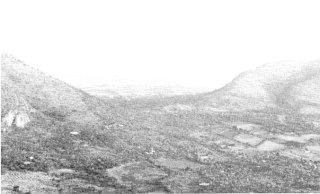
Aerial view of Silkaatsnek from the north, showing the terrain encountered by the Boers
According to the Pretoria Friend of 14 July, a subaltern (Lt Prichard or Lt Pilkington) had asked a few men to accompany him to charge the enemy. Fifteen responded, but only two of the sixteen came back. And later, two armed natives came out from the Boer lines and asked a couple of soldiers who were in a detached position to surrender. The response was a firm negative in the form of rifle shots through the head at a range of 10 yards. Neither was there any sign of response from Pretoria which had been expected about 15:00. The rescue force had set out from Pretoria only at 14:00 with 450 mounted infantry, 500 infantry and four guns, and was still six miles from the Nek by 16:00. This force included the 1st King's Own Scottish Borderers under Col D W Godfray and most of the remainder of the 2nd battalion Lincolnshires, C Coy, Capt Du Buisson and Lt F G Spring (author of the Nitrals Nek document), plus E Coy, Capt G B McAndrew and Lt Grieur. H Coy, Capt H H Harrington, was still in Pretoria.(64,65) This force had come within a few miles of the Nek when it met Alexander's units at about 20:00. The whole force had then returned to Pretoria.(66)
The abandoned force on the kopje realised the hopelessness of their position. Not even retiring by night was practicable owing to the brilliant moon and the open country to the south of the range. In addition, they had over seventy casualties. In view of the situation and to prevent more casualties, Col Roberts, himself wounded in the arm, decided to surrender shortly after sunset.(67) A white flag was raised. By this time, the Boers had overrun the camp and were looting it. In the confusion and darkness, Maj Scobell was able to escape, amid a storm of bullets, between 18:30 and 19:00 and, although pursued, managed to reach Pretoria on foot.(68) De la Rey himself came down to take over the prisoners. The wounded were allowed to proceed to Pretoria during the night and next day. The Boers assisted in carrying the wounded down the Nek.(69)
They considered their own casualties to be substantial. In his report on l2 July, de la Rey gave the number killed as six, now known to be eleven.(70) This included his nephew, Adjutant S J de la Rey Mussman (De la Rey Commando) and Adjutant C F F Roth (Ventersdorp Commando). There were eight wounded, two seriously.(e)
Casualty figures on the Imperial side differ, but twenty-two are known to have been killed and a further four Lincolnshires died of wounds and are buried in Pretoria. One of them died along the road the following evening. One man died beside the wagon before it started and was buried at the Nek.(71)
The Lincolnshires lost one officer, Lt Prichard of B Coy, and sixteen NCOs and men; Scots Greys lost two officers, Lt Conolly, and 2Lt T D Pilkington, 1st Royal Dragoons (attached), and one trooper, whilst the Royal Horse Artillery lost a driver and a gunner, a total of twenty-two.(72) 2Lt Pilkington died at Kaalboschfontein, which is near Brakpan, 70 miles (115 km) away, on 10 July, so despite his inclusion in the Scots Greys and other records for Silkaatsnek casualities, it is doubtful if he took part.(73,74,75) He is not buried in either the Rietfontein or Pretoria cemeteries; the grave site has not been identified to date. It is possible that his name was confused with that of Lt Prichard.
The Lincolnshire's dead were buried at the foot of the Nek next day, (but re-interred at Rietfontein in 1972).(f) (Map 6) For some reason, the Scots Greys and the Royal Horse Artillery dead were buried at Rietfontein the following day. The stationary tented hospital at Rietfontein did not function until October 1900, but graves from earlier months existed.
Figures for the wounded differ more widely as most of the wounded were captured on the kopje. The Lincolnshire records mention four officers, Col Roberts, the adjutant, second-in-command, Maj Herepath, wounded in the ankle, Capt J J Howley and Lt C J Rennie;(g) and twenty-seven NCOs and men wounded. The Official History gives three officers and twenty-four men of the Lincolnshires and one officer (Capt C J Maxwell who was 'shot through the kidney') and sixteen NCOs and men of the Scots Greys, which agrees with the regimental accounts. With the Flag to Pretoria provides the only mention of the artillery (two Royal Horse Artillery officers wounded), but 'O' Battery records give three gunners wounded, and the figure of 56 NCOs and men almost agrees with the Times History's total of 55 of all ranks. The thirty-one Lincolnshire casualties added to the Official History figures of seventeen Scots Greys, gives a total of forty-eight. This, together with the three RHA casualties, provides a more probable total of fifty-one.(76,77,78) Some wounded had to be left in a nearby African village. The last of the wounded were not removed until the following night, too late for two of them. They reached Pretoria at 06:00 on l3 July.(79)
Prisoner figures are similarly misleading. The Lincolnshires record the commanding officer, the adjutant and eighty-six other ranks and about seventy Scots Greys, a total of 158, which almost agrees with the Official History. The Times History says 189, including wounded, and presumably matches the figure '190 captured' reported in With the Flag to Pretoria. The whole of 2nd Section of 'O' Battery was taken prisoner, including Lt Davies. The prisoners were sent to Nooitgedacht and spent a miserable six weeks there. They were released by General French on 3 September.(80)
Thus, including killed, wounded and captured, the losses would have been 190 and 22, a total of 212. If thirty men and up to three officers, including Maj Scobell, managed to escape, as is mentioned in the Regimental History and With the Flag to Pretoria, this tallies with the original strength of 245 men.(81) This was, as it happened, almost double the strength originally intended of three companies: A Coy, 30; B Coy, 40; and G Coy, 45 men, a total of 115; plus about forty gunners to defend the Nek. Apart from the escapees, the Greys' horses had been turned loose by a sergeant in the afternoon and rejoined Headquarters in a cloud of dust and were caught at Rietfontein.(82,83) They had been sent down to the bottom of the hill under cover of the trees two days earlier.(84)
In the aftermath, there were reactions from different levels: Queen Victoria's telegram: 'Anxious to hear about the wounded in the most regrettable affair at Nitral's Nek'.(85)
Lord Roberts severely censured both Col Roberts and Col Alexander.(86) This followed the Board of Enquiry held on l4 July in Pretoria in which the former was censured for 'failure to adopt ordinary precautions' and the latter for 'want of military appreciation of the position' and failing to give assistance.(87) Col Roberts, having been captured, was not present to defend himself. He took no further part in the war, whereas Col Alexander was involved in later engagements.
The general feeling amongst army officers, cavalry in particular; was somewhat scathing towards the infantry - their 'gross stupidity';(88) that the cavalry were still there 'because their horses were tired' was not true. It was Alexander who had decided to leave them in the Nek until the next morning, because it was too late in the day when they were relieved to send them anywhere else.(89) The squadron in the Nek had rested on l0 July.(90)
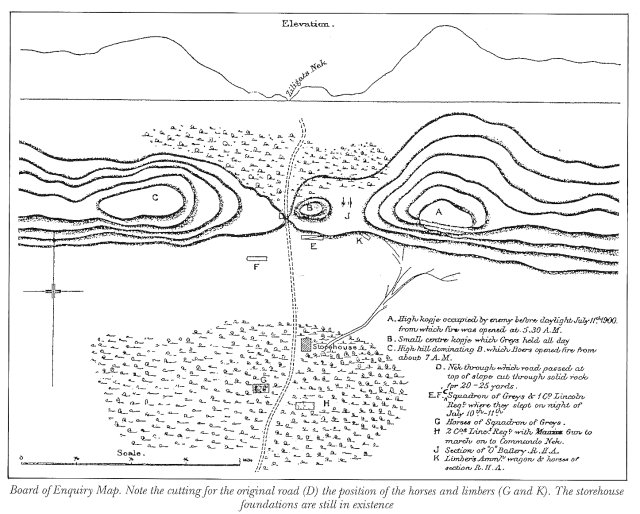
Although part of the buttress to the east had been occupied, the pickets were too far out, 800 yards (732 m) facing north in thick bush and easily surrounded. They did not command the eastern heights overlooking the kopje from whose slopes the initial shots were fired.
The western buttress seems to have been disregarded by the Lincolns until too late. The pickets out at 400 yards (365 m) with the deep gully on their left, may have felt a false sense of security. The gully could be circumvented from the north-west by climbing up to the mountain's crest and descending north-eastwards towards the kopje. (Map 3) The northern slopes of the Magaliesberg could be climbed at almost any point.
Although not mentioned specifically, the rock cutting or 'nek' for the road at the summit would have provided considerable cover for the defenders in the initial cross-fire. It would also have provided Col Roberts with a command post and a shelter for the wounded, since it was the only position providing shelter from all directions of Boer fire.
Because of the rapid onset of nightfall after his arrival, Col Roberts would have had little time to assess his position visually. Information from Maj Scobell of the Greys was such that Roberts immediately sent to Pretoria requesting urgent reinforcements. If the response to this request had been forthcoming some seven hours earlier, ie, at first light instead of the afternoon, he could have held on more confidently.
The presence of the riverine bush cover allowed D and F Coys to inflict heavy rifle fire on the eastern and western buttresses which considerably delayed the pincer movement of the Boers around the kopje, as did the all too brief bombardment of the eastern buttress from Rietfontein. This vegetation also provided a conduit for a messenger to get to Alexander (a 'trooper' in the Times History and an 'orderly' in the Official History) as well as for personnel who were able to escape.
The initial attack must have come from the lower slopes on the north-east, where the picket had been, and where the vegetation provided plenty of cover. The eastern shoulder immediately opposite the kopje has scant vegetation and lacks boulder cover except for an outcrop just below the summit, which was used by snipers.
Occupation by the Boers of the western buttress, south of the gully, meant that the kopje could now be held in a crossfire north-east/south-west. In addition, this buttress overlooks the whole southern part of the Nek. The rocky ground cover in these two directions increases with proximity to the kopje and on the eastern side overlooks the sangars which contained the guns.
Leaving the heliograph in the exposed camp during the initial confusion seems to have been the single most costly mishap, as it cut the besieged force off from communication with supporting units. This was not mentioned in defence of Alexander's conduct at the Enquiry.
The siting of the guns by the Scots Greys and the Royal Horse Artillery was such that they had a very poor field of fire due to bush having been cut back by only 200 yards. Thus targets were limited both horizontally by the vegetation, and vertically by the adjacent high ground. However; the terrain was so rugged that it would have been impossible to get the guns to a better position.
Lord Roberts' tardiness in sending out troops was possibly due, in part, to the fact that the city was, at this time, almost bereft of troops.(91) He fully expected that a serious attempt would be made to force the line of the Magaliesberg covering Pretoria.(92)
A more aggressive bombardment of the buttresses by Col Alexander could have delayed the Boers. If, indeed, he was really concerned by another Boer force, he could have remained in a well-fortified position at Rietfontein, and continued the bombardment from that point. According to the evidence of Maj Sir John Jervis-White-Jervis, the guns came into action at 08:45 at 3 000 yards (2 750 m), remained in action till 13:00 and were then withdrawn to 5 000 yards (4 570 m).(66) Owing to the likelihood of poor visibility with the targets mainly on the reverse slope, and having no forward observation, Jervis-White-Jervis could not have been expected to continue a blind bombardment. Even with good field glasses, Boer movements on the southern side of the eastern buttress would have been difficult to see. All other accounts state that the bombardment only lasted for an hour, which occasioned much criticism. Col Alexander could have moved up towards the lower Nek area and continued a more accurate bombardment plus rifle fire and become the spearhead of the relieving force had it materialised early enough. Having telegraphic and/or heliographic contact with Pretoria, he could have been informed of the progress of a more speedy relieving force. There is no evidence that the woods at the foot of the Nek were infested with Boers as Alexander feared. Perhaps he mistook the activity there of D and F Coys.
Alexander was also censured for not heeding the advice of Lord Roberts in bringing in his outlying units and concentrating them into a more powerful force.(94) He might have sent a relieving force via a gully on to the ridge of the Magaliesberg to clear the Boers off the eastern buttress (as the Royal Berkshire Regt did a month later at the second battle of Silkaatsnek.) Baden-Powell had emphasised the importance of holding both neks, but had a force five times larger at his disposal. If the Boers had not been pre-occupied with plundering the Lincoln's camp and singing hymns and psalms afterwards, they could have harassed the force returning from Commando Nek, Alexander's force or even the main relieving force, under cover of darkness, although the brilliant moonlight would have decreased their advantage of surprise.
A Boer main force could have advanced over Horn's Nek and tried to cut off the relief column from Pretoria, of which they were presumably aware.
Apart from the effect on morale on both sides, particularly the timing for the Boers of the Western Transvaal, the battle itself is not accorded great importance by most authors. Some general histories of the Anglo-Boer War do not even mention it, whilst in others, a couple of lines suffice. Four British victories on this day instead of only one might have had a significant effect on the duration of the war. Some of the lessons learnt in this action were applied only a month later on 2 August when the Boers were swept off the Nek by the Royal Berkshire Regt, but were not always applied in the next war, although the experiences of the Boer War in general were of inestimable value in 1914. Perhaps, at least, the experience helped in siting forts along the Magaliesberg a year later; in the case of Silkaatsnek one on the kopje and three on the summits of the eastern buttress. The western buttress was not used for a fort, but there is evidence of minor stone works for pickets. A mile further west, a substantial fort was built on the northern slope west of the head of the gulley. This gives a view of the kopje, eastern buttress and the whole of the northern approaches to Silkaatsnek.
(a) Onderstepoort north of Pretoria, Dwarsvlei 40 miles to the west and Witpoort to the east where the other actions on the same day took place.
(b) Silkaatsnek, also known as Mzilikatsi or Zilikaats Nek, after the Boers fought a battle in the area with the Zulu general of that name in 1838. Uitval signifies a remnant of ground on which the Nek stands or Nitrals Nek (a telegraph error for Uitval which was in use worldwide within a few days of the battle).(11)
(c) According to B K de Beer, Agter die Magalies, (Postma Publikasies, Fontainebleau, 1975) p 88, it was necessary to have a wooden bridge over the Crocodile River when the road came through Gen Schoeman's farm because of the strong flow in summer. It was thus the wet weather route to Rustenburg. The bridge, called Paul Kruger Bridge, was in use until covered by the Hartbeesport Dam in 1923.
(d) South African time after 1892 (Bloemfontein Conference) was appropriate to the meridian of 22.5 degrees east of Greenwich 1.5 hours ahead of Greenwich Mean Time until 1903, when SA Standard Time was introduced, ie, appropriate to a meridian of 30 degrees or GMT + 2 hours. Pretoria was one of the last places to observe local time. It is assumed that the army used railway and telegraphic time, GMT + 1.5 hours, thus contemporary times given would be 30 minutes earlier than present solar times quoted in brackets. Thus, 5:30 would be 06:00, 05:50 becomes 06:20 as the time would be recorded today. As sunrise was 06:50, then 06:20 of the Lincolnshire Regimental History would coincide with dawn on 11 July.
(e) Adjutants Mussman and Roth and a P J Jacobs of Elofsdaal, Pretoria, are buried beneath a recent memorial stone in the Ras family cemetery at Sandspruit 2 km north-east of Silkaatsnek. Christiaan de Wet, aged 22, and Isaac Jacob Janse van Vuuren, aged 30, lie buried, according to the National Monuments Council Boer War Graves records, in the same grave, a total of five.
Approximately 1 km further to the north-east, in a tiny separate cemetery on the north side of the Wonderboom-Rustenburg road, are the graves of Assistant Veldkornet Charel Johannes Lee, 47, one of the two severely wounded who died the same day, H C Gerber; aged 26, a man called Momsen 'en een onbekend burgher', a total of four. Their memorial is also recent.
The other severely wounded man, Johan Stephanus Schlebusch, aged 37, died on 2 August 1900 and is buried at Vissershoek, another 8 km to the north-east. To date his grave has not been identified. There are many small cemeteries in the area with early unmarked graves.
The eleventh casualty, Thiens Snyman Schoeman, age 30, was missing after the battle, presumed dead. Could he have been the 'onbekend burgher'?
(f) The Regimental History states that on 16 March 1901, the battalion marched out to the burial place of Lt Prichard and the NCOs and men who fell in this fight where two stones had been erected: one in memory of Prichard by his brother officers, and the other in memory of all who fell in this action, by the officers, NCOs and men of the battalion. The two memorial stones are still at Silkaatsnek.
(g) Lt Coverley James Rennie 'died of wounds received in action' on 26 August 1901, at the hospital at Rietfontein West, where he is buried. British War Graves Division records states, however, that he died of self-inflicted revolver wounds.
Majors Middleton and Scobell were later promoted to Brevet Lt Col and Capt Maude to Major
Maj Herepath and Capt Howley were awarded the Distinguished Service Order. Colour Sgt Breatwick and Sgt Rawdin were awarded Distinguished Conduct in the Field.
Almack, E. The History of the Second Dragoons. 'Royal Scots Greys' London, 1908.
Amery, L S. ed. The Times History of the War in South Africa. Vol IV, Lampson
LOW, London, 1906.
Carruthers, V. The Magaliesberg Southern, Johannesburg. 1990.
De Beer, B K. Agter die Magalies. Postma, Fontainbleau, Tvl, 1975.
Goldmann, C S. With General French and the Cavalry in South Africa. Macmillan,
London, 1902.
Headlam, Maj Gen Sir J. The History of the Royal Artillery. Royal Artillery
Institution, Woolwich, 1940.
Historical Records of 'O' Battery, Woolwich, The Royal Artillery Institution.
Howe, Countess. ed. Imperial Yeomanry Hospitals. Vol II. Humphries London, 1902.
Lee, A. History of the 10th Foot (the Lincolnshire Regt). Vol II Regimental Committee Aldershot.
Gale & Polden, 1911. (Lincolnshire Regimental library copy contains marginal annotations).
Maurice, Sir F. ed. History of the War in South Africa 1899-1902. Vol III
and maps to Vol III. HM Govt. London. Hurst & Blackett 1908.
Pakenham, T. Anglo-Boer War. London, Weidenfeld and Nicolson, 1979.
Paul, Sir James B. The 2nd Dragoons: Royal Scots Greys. Glasgow. James Maclehose, 1919.
Spies, S B. ed. A Soldier in South Africa: Experiences of Eustace Abadie
1899-02 Johannesburg. Brenthurst Press, 1989.
Van der Poel J, Hancock W K. Selections from the Smuts Papers. Vol I, Box
D, Memoirs of the Boer War. Cambridge University Press, 1965
Wilson, H W. With the Flag to Pretoria. Vol II. London. Harmsworth 1901.
Unpublished sources
Nitral's Nek Document. Drawn by Lt Gordon Frederick Spring, 2nd Btn Lincolnshire
Regt on 16 July 1900.
Regimental archives, Royal Anglian Regt, Lincoln.
Proceedings of a Court of Enquiry, 14 July 1900, for the purpose of investigating
the capture of certain officers and men: MS W032.
Public Record Office, Kew, London.
Diary of 'O' Battery RHA. The Royal Artillery Institution, Woolwich, London.
Letter: Maj A F Russell, MO Scots Greys to his wife in England. 15 July
1900.